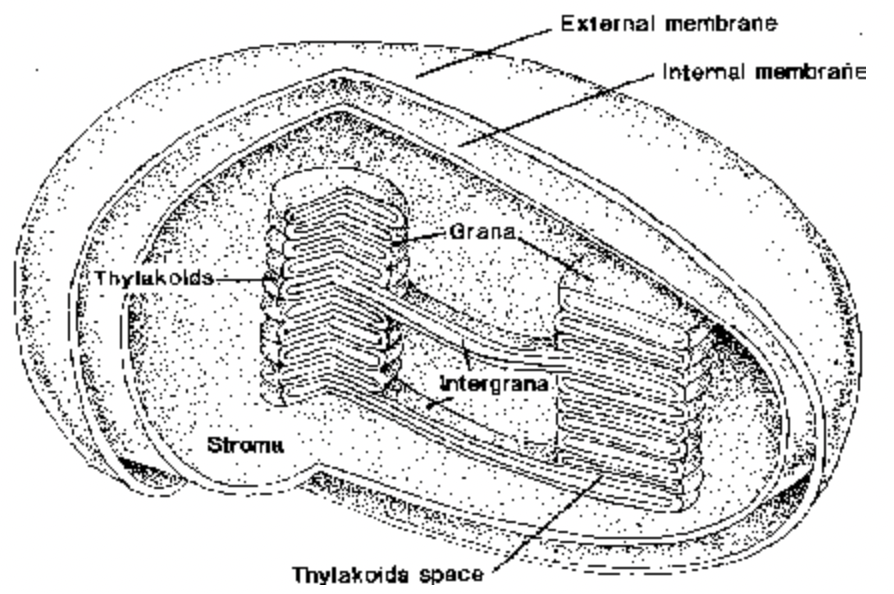
Plastids
Structure of Cell of Class 11
Double-walled, DNA containing largest organelle in plant cells discovered by Haeckel (1865)
Schimper (1883) coined the term chloroplastid for green plastids. Meyer called them Autoplast.
All types of plastids have common origin from proplastids, sac-like non-lamellar structures found in meristems.
Types :
1. Chromoplasts
Plastids containing different types of pigments (e.g. carotenes, Xanthophylls etc.). Chlorophylls either absent or occur in very less amount.
Red colour of red chillies and red tomatoes is due to a red pigment lycopene, a type of carotene.
Yellowish-orange colour of fruits is due to -carotene, -carotene and -carotene.
-carotene is precursor of vitamin A, and its rich source are carrot roots.
Choromoplasts also occur in petals but colours of petals are mainly due to water soluble pigments which occur in cell sap e.g. Anthocyanin-Blue, violet or red pigment; Anthoclor-Yellow pigment.
Chromoplasts containing various pigments (phycoerythrin and phycocyanin) are found in algae e.g. phaeoplasts in brown algae.
2. Leucoplasts :
Devoid of pigments and internal lamellar structures.
Store food in different forms like starch (Amyloplasts), fat and oil (Elaioplasts) and protein (Aleuroplasts).
3. Chloroplasts :
Green plastids discovered by Sachs (1862).
Morphology :
Double unit membrane bound cell organelles next to nucleus in size (4-6 µm × 1-3 µm).
The shape and size of chloroplasts may vary in different cells within a species, but these organelles are relatively constant within cells of the same tissue.
In leaves of higher plants, each cell contains a large number of spheroid, ovoid, or discoid chloroplasts. Chloroplasts are frequently vesicular, with colorless centers.
Shape of chloroplasts vary in different plants :
Discoidal or oval – Higher plants
Girdle-shaped – Ulothrix
Cup-shaped – Chlamydomonas
Reticulate – Oedogonium
Spiral – Spirogyra
Stellate – Zygonema
The average diameter in higher plants is 4 to 6 µm.
The number of chloroplasts is relatively constant in different plants. Algae, such as Chlamydomonas, often possess a single huge chloroplast.
In higher plants there are 20 to 40 chloroplasts per cell.
The leaf of Ricinus communis contains about 40,000 chloroplasts per square millimeter of surface area.
When the number of chloroplasts is insufficient, it is increased by division; when excessive, it is reduced by degeneration. Chloroplasts are motile organelles that have passive and active movements.
Structure :
Three main components: envelope, stroma and thylakoids.
1. Envelope made of a double limiting membrane across which the molecular interchange with the cytosol occurs. In contrast to mitochondria, the inner membrane of mature chloroplasts is not in continuity with the thylakoids.

Fig. Diagram of chloroplast showing the main structural components
2. Stroma fills most of the volume of the chloroplasts and is a kind of gel-fluid phase that surrounds the thylakoids.
Contains about 50% of the chloroplast, proteins and most of these are of the soluble type. It has
ribosomes and also DNA, both of which are involved in the synthesis of some of the structural proteins of the chloroplast. CO2 fixation and synthesis of sugars, starch, fatty acids, and some proteins takes places in stroma.
DNA of chloroplast was discovered by Ris and Plaut (1962) and named as Plastidome.
Stroma contains osmiophilic droplets called plastoglobuli that store lipids.
3. Thylakoids consist of flattened vesicles arranged as a membranous network. The outer surface of the thylakoid is in contact with the stroma, and its inner surface encloses an intrathylakoid space.
In higher plants thylakoids are arranged in stacks (10-50 thylakoid) called grana (singular-granum). Each chloroplast contain about 20-100 grana. Lamellae which connect grana are called stromal thylakoids or fret channels (Weier 1966).
In thylakoids, chlorophyll, carotenoid molecules, and a reaction centre are assembled, forming two photosystems (I and II). Each photosystem is associated with an electron transport system and with structural proteins. Lipids represent 50% of the thylakoid membrane. These include those involved in photosynthesis (i.e. chlorophyll, carotenoids, and plastoquinone) and structural lipids.
Chlorophyll, the main pigment, is an asymmetrical molecule with a porphyrin head composed of four pyrrole rings and forming a complex with a Mg atom. The molecule also has a long hydrophobic phytol chain. There are several types of chlorophylls (a, b, c, d and e). Types a and b are found in higher plants.
Quantasomes (Park and Pon 1963; Park and Biggins 1964) : are units of photosynthesis attached to grana thylakoids. Each quantasome composed of 230-250 chlorophyll molecules.
Similarities Between Mitochondria and Chloroplasts
(i) Mitochondria and Chloroplasts may have existed as independent organisms, which during evolution developed a symbiotic relationship with plant and animal cells and evolved into their present state.
(ii) Both originate and develop in the same way and are formed by the division of pre-existing organelles.
(iii) Both are semi-autonomus organelles as both contain DNA, RNA and ribosomes. Both mitochondrial DNA (mt DNA) and chloroplast DNA (cpDNA), are circular in shape although cpDNA is much bigger than mtDNA. The genetic information contained in mtDNA and cpDNA is limited.
(iv) The symbiont hypothesis suggests that there are many similarities between prokaryotes on one hand, and mitochondria and chloroplasts on the other, e.g. the presence of circular DNA not associated with histones and 70 S ribosomes.
